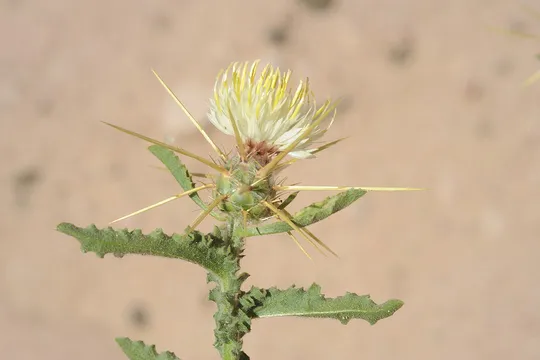Reater Chamaepeuce, Shrubby Ptilostemon
Ptilostemon chamaepeuce



Ptilostemon chamaepeuce is an evergreen shrub, about 1 m tall, with drooping branches. The whitish-wooly stems have woody bases and dense leaves on their lower section, while the upper section is almost bald and its leaves sparse. Leaves are narrow, resembling pine needles, 5-10 cm long and 1-3 cm wide, with curled back edges, dark green above and white-wooly below. At the top of the stems are inflorescence clusters with a small number of flowering heads. The flowering head is small, narrow and elongated, 12-16 mm wide. The flowering head bracts are linear, short and narrow, with a sharp tough thorn at their ends, which is occasionally slightly hooked backwards. All the flowers are tubular, pink to purple. The achene has a white tuft (pappus) with feathery bristles, joined at their base to form a ring. P. chamaepeuce blooms in late spring, from early May to mid-June. Seeds are dispersed by wind.
Ptilostemon chamaepeuce grows in only one region west of the Jordan, in
the Upper Galilee, but it is also found at the foot of Mount Hermon.
Eliezer Smoli first collected the species in 1925 in the Ayun Stream
near Metula and this is the only site in Israel where it currently
grows. On Mount Hermon it is relatively common on the limestone cliffs
of the Mediterranean zone, in the streams that descend from Mount Hermon
to the west – Wadi Si'on, Wadi Govta and Wadi Hazor, at an altitude of
(300) 500-900 m.
The species is noted in the Flora Palaestina from the Golan, but this is
probably a mistake. In the old field guide (1948) the species is noted
from the “cliffs facing the sea in the Upper Galilee". Consequently,
many searched for it on the Rosh HaNikra cliffs and in the western Upper
Galilee, but the species was not found there. The data is most probably
faulty, and the specimen was apparently collected on the Ras al Beiada
cliffs in southern Lebanon, north of the international border – this
site is similar to the Rosh HaNikra cliffs and only about ten kilometers
north of it (Schmida and Lev-Ari 1982).
In Israel, Ptilostemon chamaepeuce is limited to rock outcrops near
exposed limestone cliffs. It belongs to the ecological group of
cliff-dwelling plants, and is a dominant species on large cliffs
towering over deep streams. It can also be found on rocky slopes near
cliffs.
The genus Ptilostemon has circa 15 species, some perennial herbs with prickly leaves and a few low shrubs with pine-like needle leaves. Its species are found mainly in the Mediterranean region, and penetrate east up to the Caucasus. The inflorescences of the genus are thorny or have thorny bracts and are similar to the capitula of Cirsium. In most species, the leaves and the bracts of the capitulum are thorny, like that of P. diacantha that grows on the high Hermon. The needle leaves and smooth capitulum bracts are probably related to the hilly habitat of Ptilostemon, which is not threatened by cattle and sheep grazing.
• Ptilostemon chamaepeuce is endangered because it grows in Israel at a single site in a small area (hundreds of square meters), in the Ayun Stream.
• The plant is striking, but is not really threatened by cutting or picking. Access to the plants at the site is difficult, although some of the plants grow near well-traveled, marked trails.
• The species is limited to a habitat of limestone cliffs surrounded by rocks. The habitat is not vulnerable nor is it sensitive to development.
• The population size in the Ayun Stream Nature Reserve in 1995 was 200 plants and it is apparently stable and produces seeds.
• P. chamaepeuce is protected in the Ayun Stream Nature Reserve.
• The species is common in the eastern Mediterranean and is not globally endangered.
The Ptilostemon chamaepeuce population in the Ayun Stream should be monitored over the long term. Another site, the Wadi Govta cliffs near the Nimrod Fortress, which is located within the central optimal range of P. chamaepeuce at the foot of Mt. Hermon should be declared and monitored.
Ptilostemon chamaepeuce has an eastern Mediterranean distribution: it grows in Greece and Crete, Turkey, Cyprus, Syria-Lebanon and northern Israel.
Ptilostemon chamaepeuce is a unique cliff shrub that dominates on limestone cliffs in the eastern Mediterranean basin. Israel has only a small number of plants, in a single site, whose area is limited. This is the southern limit of its global distribution, and thus it is of great importance to nature conservation.
P. chamaepeuce grows in the Mediterranean zone in the western section of the base of Mount Hermon. It is common in the Wadi Govta and Wadi Si'on cliffs. The location in Israel (the Ayun Stream) is located about 13 km west of Wadi Si'on. The Ayoun Stream population is associated with the distribution of the species on the Hermon, which explains its absence from the other Galilee cliffs.
שמידע, א. ולב-ארי, י. 1982. הצומח והיערות של דרום לבנון. רתם 72:5.
Current Occupancy Map
| 1000 squre meter pixel | 5000 squre meter pixel | 10000 squre meter pixel | |
|---|---|---|---|
| number of observations | 0 | 0 | 0 |
| in total pixels | 0 | 0 | 0 |
| Family | Asteraceae |
| Classification | On the near threatened species list |
| Ecosystem | Mediterranean |
| Chorotype | Eastern Mediterranean |
| Conservation Site | Ayun Stream, Wadi Govta (near Nebi Hazuri) |
| Rarity |
1
4
6
|
|---|---|
| Vulnerability |
0
0
4
|
| Attractiveness |
0
0
4
|
| Endemism |
0
0
4
|
| Red number |
1
2.6
10
|
| Peripherality | N |
| IUCN category | DD EW EX LC CR EN VU NT |
| Threat Definition according to the red book | Near threatened |
 Based on:
Based on:






